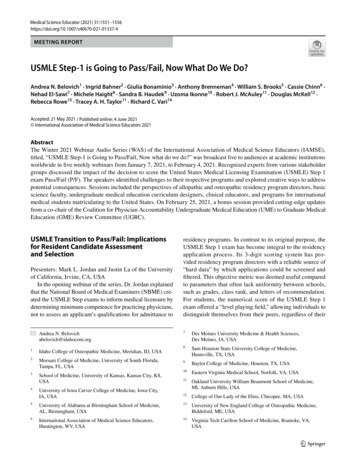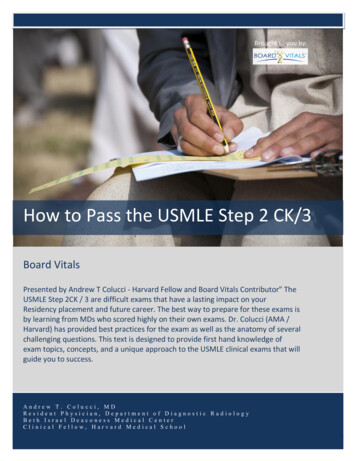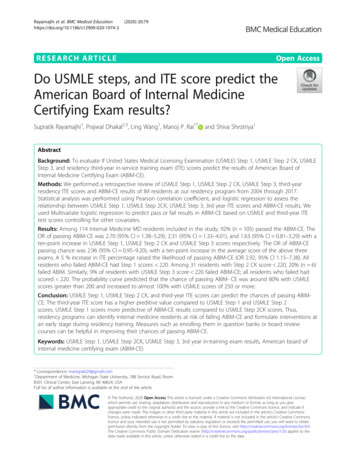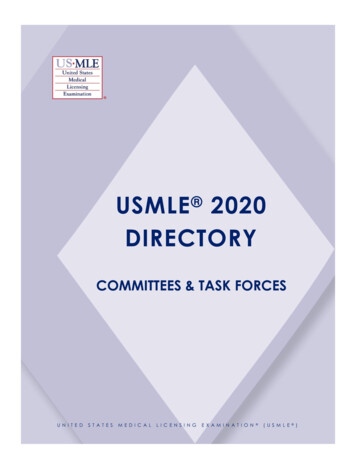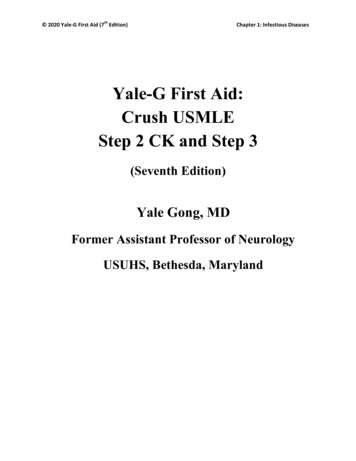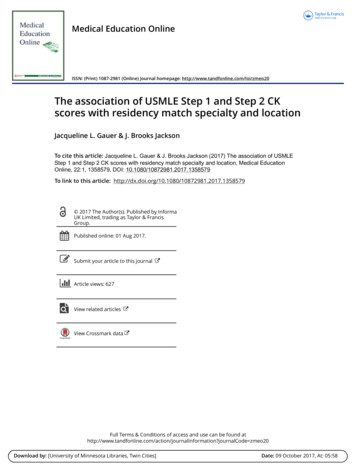
Transcription
Medical Education OnlineISSN: (Print) 1087-2981 (Online) Journal homepage: http://www.tandfonline.com/loi/zmeo20The association of USMLE Step 1 and Step 2 CKscores with residency match specialty and locationJacqueline L. Gauer & J. Brooks JacksonTo cite this article: Jacqueline L. Gauer & J. Brooks Jackson (2017) The association of USMLEStep 1 and Step 2 CK scores with residency match specialty and location, Medical EducationOnline, 22:1, 1358579, DOI: 10.1080/10872981.2017.1358579To link to this article: http://dx.doi.org/10.1080/10872981.2017.1358579 2017 The Author(s). Published by InformaUK Limited, trading as Taylor & FrancisGroup.Published online: 01 Aug 2017.Submit your article to this journalArticle views: 627View related articlesView Crossmark dataFull Terms & Conditions of access and use can be found tion?journalCode zmeo20Download by: [University of Minnesota Libraries, Twin Cities]Date: 09 October 2017, At: 05:58
MEDICAL EDUCATION ONLINE, 2017VOL. 22, 79RESEARCH ARTICLEThe association of USMLE Step 1 and Step 2 CK scores with residency matchspecialty and locationJacqueline L. Gauera and J. Brooks JacksonbDownloaded by [University of Minnesota Libraries, Twin Cities] at 05:58 09 October 2017aUniversity of Minnesota Medical School, Minneapolis, MN, USA; bUniversity of Minnesota, Minneapolis, MN, USAABSTRACTARTICLE HISTORYBackground: For future physicians, residency programs offer necessary extended training inspecific medical specialties. Medical schools benefit from an understanding of factors thatlead their students to match into certain residency specialties. One such factor, often usedduring the residency application process, is scores on the USA Medical Licensing Exam(USMLE).Objectives: To determine the relationship between USMLE Step 1 and Step 2 ClinicalKnowledge (CK) scores and students’ residency specialty match, and the association betweenboth USMLE scores and state of legal residency (Minnesota) at the time of admission withstudents staying in-state or leaving the state for residency program.Design: USMLE scores and residency match data were analyzed from five graduating classesof students at the University of Minnesota Medical School (N 1054).Results: A MANOVA found significant differences (p 0.001) between residency specialtiesand both USMLE Step 1 and Step 2 CK scores, as well as the combination of the two. Studentswho matched in Dermatology had the highest mean USMLE scores overall, while studentswho matched in Family Medicine had the lowest mean scores. Students who went out ofstate for residency had significantly higher Step 1 scores (p 0.027) than students who stayedin-state for residency, while there was no significant difference between the groups for Step 2scores. A significant positive association was found between a student who applied as a legalresident of Minnesota and whether the student stayed in Minnesota for their residencyprogram.Conclusions: Residency specialty match was significantly associated with USMLE Step 1 andUSMLE Step 2 CK scores, as was staying in-state or leaving the state for residency. Studentswho were legal residents of the state at the time of application were more likely to stay instate for residency, regardless of USMLE score.Received 3 April 2017Accepted 17 July 2017KEYWORDSLicensing exams; USMLE;residency; specialty; careerplanningAbbreviations: CK: Clinical knowledge; COMLEX: Comprehensive Osteopathic MedicalLicensing Examination; GME: Graduate medical education; NRMP: National ResidentMatching Program; UME: Undergraduate medical education; USMLE: United States MedicalLicensing ExaminationIntroductionIn the USA, medical education is completed throughtwo steps. The first step, undergraduate medical education (UME), is completed after a bachelor’s degree,typically lasts four years, and is historically comprisedof a foundational sciences coursework phase and aclinical phase (although the current trend is towardsintegration of the coursework and clinical experiences). After UME, a student generally proceeds onto graduate medical education (GME), often referredto as ‘residency,’ for further training as a physician.Since medical practice often requires in-depth andspecific knowledge and experience, residency programs are focused on training physicians in specificspecialties, such as pathology, surgery, or psychiatry.Students are matched with a residency program intheir preferred specialty through a competitive process, referred to as ‘The Match,’ facilitated by theCONTACT J. Brooks JacksonJacksonB@umn.eduNational Resident Matching Program (NRMP). Oneof the major goals of an undergraduate medical education institution is to prepare medical students for asuccessful residency match.Every residency program has different criteria fordetermining whether to accept a candidate into theirprogram. One frequently-used criterion is the applicant’sscore on the United States Medical LicensingExamination (USMLE). The USMLE is a three-stepexamination sponsored by the Federation of StateMedical Boards and the National Board of MedicalExaminers (NBME) required for physician licensure forall physicians, regardless of training location, to practicein the USA. Typically, for medical students receivingtraining at Liaison Committee on Medical Education(LCME) accredited institutions in the U.S. and Canada,students take Step 1 of the USMLE at the end of thesecond year of medical school, and Step 2 ClinicalUniversity of Minnesota, MC 293 C607, 420 Delaware St SE, Minneapolis, MN, USA. 2017 The Author(s). Published by Informa UK Limited, trading as Taylor & Francis Group.This is an Open Access article distributed under the terms of the Creative Commons Attribution License (http://creativecommons.org/licenses/by/4.0/), which permitsunrestricted use, distribution, and reproduction in any medium, provided the original work is properly cited.
Downloaded by [University of Minnesota Libraries, Twin Cities] at 05:58 09 October 20172J. L. GAUER AND J. B. JACKSONKnowledge (CK) and Clinical Skills (CS) in the fourthyear of medical school. Together, Step 1 and Step 2 CKassess a physician’s ability to apply knowledge and concepts to provide safe and effective patient care. Step 1assesses whether medical students understand and areable to apply important concepts of basic science tomedical practice, with special emphasis on principlesunderlying modes of therapy, health, and disease. Step 2CK further assesses health promotion and disease prevention and strives to devote attention to incorporatingprinciples of clinical sciences and basic patient-centeredskills for safe practices of medicine [1]. Since Step 3 istypically taken well after students have been matched to aresidency program, it does not play a role in residencymatch decisions, and is therefore not analyzed in thecurrent study. The USMLE was not originally intendedto be used in selection decisions, but, as it is a rigorousstandardized exam that is taken by almost every applicantwho participates in the Match, many residency programdirectors have found it to be a useful measure for comparing candidates from various UME institutions.The NRMP releases an annual report whichincludes the medians and interquartile ranges ofStep 1 and Step 2 CK scores for the applicants whosuccessfully or unsuccessfully matched in each residency specialty. Since certain residency specialties aremore competitive than others, patterns can be foundin the USMLE scores of students accepted into eachdifferent specialty [2]. These patterns indicate thatstudents may need higher USMLE scores to be successfully matched into certain specialties. Indeed, students are often advised to consider their own USMLEscores when deciding which specialties and programsto rank. In one survey, students applying to residencyprograms universally regarded Step 1 scores as one ofthe top academic factors considered by residencyprogram directors when evaluating applicants forresidency [3]. Their perceptions are well-founded: inthe 2014 national survey of residency program directors across all specialties conducted by the NRMP(N 1793), the USMLE Step 1 / COMLEX(Comprehensive Osteopathic Medical LicensingExamination) Level 1 score was the most commonlycited factor in selecting applicants to interview, with94% of respondents indicating that they consideredStep 1/ COMLEX Level 1 scores when selecting applicants, while 80% indicated that they considered Step2 CK / COMLEX Level 2 Cognitive Evaluation (CE)scores. When ranking applicants, 80% of respondentsindicated that they considered Step 1 / COMLEXLevel 1 scores and 71% Step 2 CK / COMLEX Level2 CE [4]. In specific specialties, a national survey ofneurological residency program directors found thatthe Step 1 score was rated as the 2nd most importantfactor overall in the resident selection process [5],and a survey of general surgery program directorsfound that the Step 1 score was rated as the mostimportant factor in the initial screening of applicants [6].The use of USMLE scores in the residency program selection process is generally well-supported inthe literature, as multiple studies have found USMLEscores to be related to several measures of success inresidency programs. Particularly strong associationshave been found between USMLE scores and otherexam-related measures of success, such as scores onin-training examinations in specialties such as dermatology [7], emergency medicine [8], general surgery [9], and neurology and neurosurgery [10], aswell as across specialties in meta-analyses [11,12].Other positive associations were found betweenUSMLE scores and a resident’s likelihood of successfully passing board examinations [12,13], especiallyon the first attempt [14,15]. On the other hand,USMLE scores tend to not be as strongly correlatedwith more subjective outcome measures, such assupervisor and faculty evaluations [10,11,15].Although some researchers have argued that thevalidity argument for using USMLE scores in residency program selection is ‘neither structured, coherent, nor evidence-based’ due to the lack of associationbetween USMLE scores and measures of clinical skillacquisition [16], and others warn of the possibleexistence of racial bias when USMLE scores areused in residency program selection decisions [17],the fact remains that USMLE scores are generallyconsidered, by both applicants and program directorsalike, to be an important factor in the residencyprogram selection process.Medical school leaders can benefit from an enhancedunderstanding of the factors that affect the residencyspecialty choices of their students. Previous literaturehas explored many possible factors that affect specialtychoice, including personality and values [18], medicalschool experiences and financial aid [19], and gender[20]. Research has also shown that residents’ reasons forchoosing a specific specialty varies by specialty [20,21].One factor that has not been as deeply explored is theassociation between USMLE scores and residency specialty choice. Since USMLE scores are an important partof the residency selection process from the perspectivesof both program directors and applicants, and sincemedian USMLE scores vary widely by specialty [2], itfollows that a student’s USMLE score might influencethe specialty in which they match. One of the goals ofthe current study was to use statistical analysis toexplore this association in a large sample of students,from one institution, across several years. Furthermore,when the NRMP reports match statistics, they report onthe specialty students match into for their first year ofresidency. For many students, the first year is a preliminary residency, and they then continue on into anadvanced residency in a different specialty. Thisadvanced residency is the specialty that those students
Downloaded by [University of Minnesota Libraries, Twin Cities] at 05:58 09 October 2017MEDICAL EDUCATION ONLINEactually intend to practice in. Therefore, the NRMPdata may not reflect the actual final career paths of allstudents. By choosing to use the advanced residencydata for our students with multiple residencies, we canmore accurately reflect the relationships between examscores and final specialty career choices.At a public state institution, such as the institutioninvolved in the current study, medical school leadersmay notice a particular physician workforce need intheir state, and wonder how to direct students to theneeded specialty. In a situation like this, it is also helpful for medical school leaders to understand whatmight predict the geographic locations where theirstudents go for residency. For example, if a publicstate university is located in a state that has a deficitof family medicine practitioners, it is incumbent on theleaders of that medical school to select and train futurephysicians who will both be interested in family medicine and elect to remain in that state. Although a 1982survey found that geographic region was regarded asthe most important factor in choice of specific residency program for seniors from 37 American medicalschools [21], the literature on the role of location inspecialty program choice is relatively lacking. The current study makes initial attempts at finding patterns instudents’ choice of residency program on the dimensions of both specialty and location.For this study, we analyzed USMLE scores andresidency placement data for students from five graduating classes at the University of Minnesota MedicalSchool in order to answer the following researchquestions: (1) What is the association betweenUSMLE scores and residency specialty? (2) Whichspecialties have higher mean USMLE scores? (3) Isthere a relationship between USMLE score andwhether a student stays in-state for residency? (4)Are students who identify as legal residents of thestate during the medical school application processmore likely to stay in-state for residency?MethodsInstitutional approvalEthical approval for this research was granted by theInstitutional Review Board at the University ofMinnesota on 19 March 2015. Reference number:1503E66021.ParticipantsThe participants for this study included all studentspursuing MD (N 1049) and MD/PhD (N 5) degreesat the University of Minnesota who both matriculatedbetween 2007 and 2011 and graduated between 2011and 2015, and who successfully matched into a residency program (total N 1054). Of the included3students, 535 (50.8%) were male and 519 (49.2%) werefemale. Age at matriculation ranged from 19 to 42 years(M 23.7 years, SD 2.5 years). At the University ofMinnesota, medical students matriculate at either theTwin Cities campus or the Duluth campus. They complete the first two years of the degree (foundationalscience courses) at their campus of matriculation, andthen all students complete the second two years of thedegree (clinical clerkships) through the Twin Citiescampus. Of the students in this study, 280 (26.6%)matriculated at the Duluth campus and 774 (73.4%)matriculated at the Twin Cities campus.Sources of dataAcademic and demographic data, including date ofmatriculation, date of graduation, and residencymatch information, were collected from student recordsheld by the Office of Medical Education in theAcademic Health Center at the University ofMinnesota. Data regarding participants’ age at matriculation, gender, and state of legal residency wereretrieved from the University of Minnesota’s access toprimary application data through the AmericanMedical College Application Service (AMCAS). Forthis study, a student’s state of legal residency was determined based on which state they self-identified as theirstate of legal residency during the AMCAS applicationprocess. Data regarding participants’ USMLE Step 1and Step 2 CK scores were provided to the MedicalSchool by the National Board of Medical Examinersupon students’ completion of each exam.AnalysesUsing SPSS Statistics v.22 (IBM: USA), we conducted aone-way between-groups multivariate analysis of variance (MANOVA) to investigate residency specialtydifferences in USMLE scores. The two dependent variables were Step 1 scores and Step 2 CK scores, and theindependent variable was residency specialty. We conducted preliminary assumption testing to check formultivariate normality, homogeneity of variance-covariance matrices, and multicollinearity, with no seriousviolations noted. Due to the wide range of N values ineach specialty group (5–205), we chose to use Pillai’sTrace as our test statistic, as it is relatively robust tounequal N values [22]. We also conducted independent-samples t-tests for students who stayed in-statevs. went out-of-state for residency to explore groupdifferences in scores on the USMLE. Finally, we conducted a chi-square test of association to determinewhether there was a significant association betweenwhether a student was a legal resident of Minnesota atthe time of application to medical school and whetherthey stayed in-state for residency.
Downloaded by [University of Minnesota Libraries, Twin Cities] at 05:58 09 October 20174J. L. GAUER AND J. B. JACKSONWe coded the specialties matched into by our students, following the specialty categories used by theNational Resident Matching Program [2]. However,since some specialties were not well-represented inour sample, we combined certain small specialtieswith related larger specialties. We combined ChildNeurology with Neurology, and we also combined several surgical specialties (Neurosurgery, Plastic Surgery,and Vascular Surgery) into a single Neuro/Plastic/Vascular Surgery category. Ultimately, we were leftwith the following 20 specialties: Anesthesiology(N 52), Dermatology (N 17), Emergency Medicine(N 88), Family Medicine (N 205), Internal Medicine(N 199), Internal Medicine/Pediatrics (N 40),Neuro/Plastic/Vascular Surgery (N 5), Neurology(N 25), Obstetrics-Gynecology (N 50),Ophthalmology (N 17), Orthopedic Surgery(N 41), Otolaryngology (N 15), Pathology(N 13), Pediatrics (N 112), Physical Medicine andRehab (N 7), Psychiatry (N 47), Surgery (N 74),Radiation Oncology (N 5), Diagnostic Radiology(N 31), and Urology (N 11).For students who were accepted into both a transitional and an advanced residency, we used the specialty and location of the student’s advanced residencyin our analyses.ResultsA one-way MANOVA found a statistically significantdifference between residency specialties on thecombined dependent variables, F (38, 2068) 8.307,p 0.001; Pillai’s Trace 0.265; partial etasquared 0.132. When the results for the dependentvariables were considered separately, both reached statistical significance using a Bonferroni adjusted alphalevel of 0.025. For Step 1, F (19, 1034) 15.427,p 0.001, partial eta squared 0.221. For Step 2 CK,F (19, 1034) 7.872, p 0.001, partial etasquared 0.126. Charts showing the mean Step 1 andStep 2 CK scores by specialty can be found in Figures 1and 2, respectively. In this dataset, students matchinginto Dermatology had the highest mean scores, andstudents matching into Family Medicine had the lowestmean scores, for both Step 1 and Step 2 CK.When the data are broken down into individualgraduating classes, the MANOVA analysis is significant (p 0.001) for each of the five years in the study,as is the univariate ANOVA analysis for Step 1. ForStep 2 CK, all years are significant (p 0.01) exceptfor the 2011 graduates.We conducted independent-samples t-tests toexplore whether USMLE Step 1 and USMLE Step 2CK scores were related to whether students stayed instate or went out-of-state for residency. We found asignificant difference between those who stayed instate (M 225.24, SD 19.084) and those who wentout-of-state (M 227.83, SD 18.668) at the p 0.05level on USMLE Step 1 scores (t(1052) 2.215,p 0.027). However, we did not find a significantdifference at the p 0.05 level between those whostayed in-state (M 237.81, SD 16.587) and thoseFigure 1. United States Medical Licensing Examination Step 1 mean scores by specialty of residency match for graduates of theUniversity of Minnesota Medical School from 2011 to 2015 (total N 1054). Overall Step 1 mean score: 226.69.
Downloaded by [University of Minnesota Libraries, Twin Cities] at 05:58 09 October 2017MEDICAL EDUCATION ONLINE5Figure 2. United States Medical Licensing Examination Step 2 Clinical Knowledge (CK) mean scores by specialty of residencymatch for graduates of the University of Minnesota Medical School from 2011 to 2015 (total N 1054). Overall Step 2 CK meanscore: 238.38.who went out-of-state (M 238.83, SD 16.066) onUSMLE Step 2 CK scores (t(1052) 1.011, p 0.312).These results suggest that, although both Step 1 andStep 2 CK scores were higher on average for studentsgoing out-of-state for residency, only Step 1 scoreswere significantly different.We also explored whether students who were legalresidents of Minnesota were more likely to stay instate for residency than students who were not legalresidents of Minnesota, regardless of USMLE score.Numbers and percentages of residents and non-residents staying or leaving the state for residency can befound in Table 1. Using a chi-square test of association, we found that the percentage of students whowent out-of-state for residency did differ significantlyby legal residency status, χ2(1, N 1054) 20.111,p 0.001. Students who were not legal residents ofMinnesota at the time of application to the medicalschool were less likely than those who were legalresidents to stay in Minnesota for residency.DiscussionIn our dataset of 1054 students, we found significantassociations (p 0.001) between both USMLE Step 1and USMLE Step 2 CK scores and residency specialty,indicating that a relationship exists between examscores and specialty match. While this is the firststudy we are aware of that explores these differencesstatistically, this finding is consistent with previousTable 1. Numbers and percentages of Minnesota (MN) residents and non-residents staying in-state or leaving the statefor residency.LegalresidencystatusN (percentof total)MN resident 890 (84.4%)Not MN164 (15.6%)residentTotal1054Primary residencymatch in MNPrimary residencymatch not in MN418 (47.0%)46 (28.0%)472 (53.0%)118 (72.0%)464 (44.0%)590 (56.0%)literature that shows differences in mean exam scoresacross specialties on the national level. Furthermore,the specialties with the highest (Dermatology) andlowest (Family Medicine) mean USMLE scores inour dataset are consistent with the specialties showingthe highest and lowest median scores in the nationalMatch data from the NRMP [2]. It is reasonable tobelieve that this pattern is maintained at least in partby students with lower scores either not achievingadmission to the most competitive programs or selfselecting into specialties with USMLE scores moresimilar to their own. Conversely, students with highUSMLE scores may feel pressured to aim for themore ‘prestigious,’ competitive programs, and students aiming for those competitive programs maydedicate more of their time and energy to studyingfor the USMLE.Our results also provide evidence that a relationship exists between USMLE Step 1 scores and students leaving the state for residency. This relationshipmay be caused by students with higher scores
Downloaded by [University of Minnesota Libraries, Twin Cities] at 05:58 09 October 20176J. L. GAUER AND J. B. JACKSONapplying to and being accepted by the most prestigious programs, which are not necessarily in-state.Also, the most competitive specialties tend to besmaller, so students may have fewer local choices,and may need to seek programs out-of-state both tofind a program they like and to improve their chancesof matching. It is important to note that even thoughthis difference was significant, the mean differencewas only 2.59 points. Students and institutions mayfind that difference meaningful or not depending ontheir context.Interestingly, our findings did not indicate a relationship between Step 2 CK scores and location ofresidency. This may be due in part to the timing ofwhen students take Step 2. Many students have nottaken Step 2 by the time they apply for the Match,and many programs do not require Step 2 scores intheir application process [2]. Therefore, Step 2 scoresmay be less influential overall in the residency matchprocess.These findings have implications for public medical schools, such as the University of Minnesota,which are charged with the task of developing futurephysicians to meet the workforce needs of their state.A large body of literature provides evidence thatMedical College Admission Test (MCAT) scores arepredictive of USMLE scores [23–25], so if an institution needs to develop, for example, dermatologists,for a state that is lacking in such, the institution maybe well-served to select students with high MCATscores, or to provide extra USMLE study support.Conversely, if a state is in need of more family physicians, a focus on standardized exam scores overother priorities may be unwarranted. The results ofthe in-state/out-of-state analyses contribute additional nuance to these considerations.LimitationsIt is important to note that these data reflect theexperiences of students at only one medical school.Different medical schools may see different results.However, the national-level data do reflect similarpatterns in which residency specialties have highermean USMLE scores [2].This study is also limited in its ability to represent allresidency specialties equally. Even though the overallsample size of 1054 students is quite large, certainspecialties, such as vascular surgery and child neurology, had less than five students, and were thereforecombined with larger specialties for the sake of thestatistical analysis. For example, only one student inthis dataset was matched into a vascular surgery residency program. The USMLE scores of that studentwould have placed vascular surgery at the top of thelists of specialties ranked by USMLE scores. Thesenuances are not currently reflected in the results.Furthermore, even though the smallest specialtieswere combined, there were still several specialties leftwith very small sample sizes. This left us with 20 groups,with group sizes ranging from 5 to 205. This makes theinterpretation of the MANOVA results more difficult,and also precludes in-depth post-hoc testing. The widerange of group sizes also introduces a concern that thegroups would also have differing variances, violating theequality of variances assumption for a MANOVA.However, the standard rule of thumb is thatMANOVAs are relatively robust to heterogeneity ofvariance as long as the largest variance is not more than4 times the smallest variance. In our sample, the smallestStep 1 variance was 197.82, and the largest variance was422.80. The smallest Step 2 CK variance was 120.65 andthe largest was 351.90. Therefore, our data do not violatethe assumption of equality of variance.One further limitation of this research is that theUSMLE was not designed to be used, as it currently is,in the residency match process. Certainly, the use ofUSMLE scores in this way greatly increases the pressureand anxiety students feel when studying for the licensingexams – instead of simply needing a passing grade, theyare competing against other students nationally for thehighest score. Several authors have argued that the use ofUSMLE exams in residency match is not based on evidence of eventual clinical performance [16] and plead fora move to a more holistic approach [26]. However,regardless of whether or not USMLE scores should beused in the residency match process, they currently doplay a large role, and so it is important for medicalschools to understand the relationships betweenUSMLE scores and residency choices.ConclusionThe results of our study support our hypotheses thatthere is an association between USMLE scores andresidency specialty, and our findings reflect nationalpatterns as to which specialties have the highest andlowest USMLE scores. Students with higher USMLEscores were more likely to match out-of-state, butstudents who were legal residents of the state uponapplication to medical school were more likely toremain in-state for residency regardless of USMLEscore. These results can help guide decision-makerswhen determining which students to admit to theirinstitution, and how to best support students in bothtaking the USMLE and applying for residency.Authors’ contributionsJLG is responsible for data acquisition and analysis, interpretation of findings, and the preparation of this manuscript. JBJ is responsible for the conceptualization andoversight of this study and revision of this manuscript.All authors reviewed and approved the final manuscript.
MEDICAL EDUCATION ONLINEJLG is responsible for data acquisition and analysis, interpretation of findings, and the preparation of this manuscript. JBJ is responsible for the conceptualization andoversight of this study and revision of this manuscript.All authors reviewed and approved the final manuscript.[10][11]AcknowledgmentsDownloaded by [University of Minnesota Libraries, Twin Cities] at 05:58 09 October 2017The authors wish to thank Barb Smith and JonathanMarston for their help in providing the data, Suzannevan den Hoogenhof for her assistance revising themanuscript, and Claudio Violato for his assistancewith statistical analysis.Disclosure statement[12][13][14]No potential conflict of interest was reported by theauthors.[15]FundingThe University of Minnesota Medical School providesfunding for the salaries of the authors.References[1] National Board of Medical Examiners. What isUSMLE? USMLE website. [cited 2016 Mar 28].Available from: http://www.usmle.org/ (Archived byWebCite at http://www.webcitation.org/6gLlA2F2A).[2] National Resident Matching Program. Chartin
Design: USMLE scores and residency match data were analyzed from five graduating classes of students at the University of Minnesota Medical School (N 1054). Results: A MANOVA found significant differences (p 0.001) between residency specialties and both USMLE Step 1 and Step 2 CK scores, as well as the combination of the two. Students





